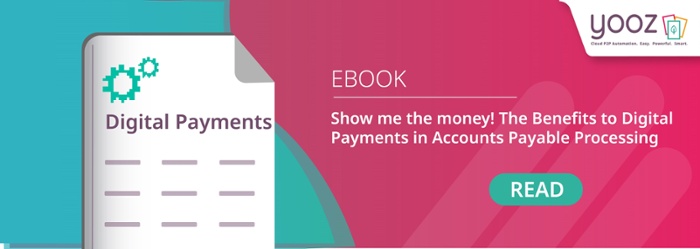The days of the paper check are numbered. This sounds somewhat ominous when you consider that according to the Association for Financial Professionals (AFP) 86% of businesses still cut paper checks, making them the preferred payment method ahead of established electronic options such as ACH. However, the increased need to adapt the way that we conduct business means that change is in the air.
Why are checks a dying breed? New technology solutions are fueling digital transformation as a means for getting ahead, allowing organizations to become more efficient and competitive by automating and digitizing their accounts payable process. Paying every invoice on time, every time is quickly becoming a top priority - driven by necessity - for businesses. This processing technology, known as payment automation, helps to optimize their cash management, boost security, and keep suppliers happy.
As part of the process, ePayables are gaining traction as the most promising contender to topple paper checks thanks to their ability to lower costs, speed up turnaround time, and offer safeguards against rising issues such as errors, fraud, and other cyber-attacks. In fact, at last count approximately 31% of companies reported that they’ve already begun using this secure and quick form of payment.
What Exactly are ePayables?
ePayables are essentially virtual cards, a form of electronic payment that works like a credit card to pay an invoice but is completely digital. It is a secure way to process payments in real-time that helps reduce paper dependency and waste, exposure to the possibility of check fraud, and can significantly decrease the amount of time involved in paying suppliers.
The way an ePayable virtual card program works is fairly straightforward. During supplier enrollment, a vendor can select ePayables as a form of payment. They are then assigned an individual 16-digit number, expiration date and security code. Once the AP team - the buyer - has reviewed and approved an invoice, it authorizes a bank to fund the vendor's card for payment. The vendor then receives a notification via a pre-designated method (with digital payments the payment information and remittance advice is typically sent via email to inform the supplier that the invoice has been paid).
Whether it’s for online transactions, over the phone or for setting up automatic payments, b2b virtual cards are a quick and easy way to pay.
What are Some of the Benefits to ePayables?
There are significant benefits to using ePayables, especially as the last step in an end-to-end AP automation process. These include:
1. Reducing manual processing
Simply put, switching to automated invoice processing complete with digital payments means that all the tedious, repetitive tasks are reduced or eliminated. No more manual entry and in the case of ePayables, no more printing, signing, mailing, opening, endorsing, or depositing checks. No more hunting down lost, mixed up, or late checks. The entire process is more efficient, easier with an increasingly hybrid or remote workplace, and employees are happier.
2. Lowering cost per payment
Eliminating a need for manual (check) processing has several benefits.
3. Decreasing fraudulent payments
Its no secret that errors and fraud are on the rise. Digital payments means that there are no physical items to steal, easily traceable digital audit trails, and the ability to expire once the payment has been made to the recipient. No sensitive banking information will be exposed. The entire transaction process is more secure by nature, decreasing the chance of fraudulent payments.
4. Improves accuracy
Amounts and payment schedules can be automatically set, especially in the case of recurring payments. Not only can the finance team can better control spending and tap into a detailed digital audit trail tied to each virtual card number, but chances of duplicate payments are eliminated and reconciliation is a seamless process
5. Optimizes and increases working capital
The ability to instantly execute payment means that an organization can hold on to cash for a longer period, still paying on time, and still reap discounts. This allows the company to collect more return on those funds as working capital.
In addition, companies can unlock a new, almost effortless revenue stream thanks to cash-back rebates on every payment made. These cashbacks or rebates quickly add up, turning an old-school back-office cost center into a cutting-edge value driver for a company.
6. Improves supplier relationships
Providing a streamlined supplier experience - one where payments area easily traced and done in real-time - makes supplier part of your business network rather than just a counterparty in a b2b transaction. In fact, suppliers are much more likely to accept virtual cards since they cost less for them to process, funds are deposited faster versus paper checks, the payment or payment information can't be intercepted, and historical data is easily (and quickly!) available
What About Fees?
There is no cost to create a virtual credit card, however there is a small service fee applied that can vary according to the merchant network and ranges from anywhere between 1.29% up to 3.5%. That cost needs to be put into perspective, though, because the old way of manually handling invoices and checks costs an average of $12.40 per single invoice, not including the additional work involved when problems occur or payments go missing. Nor does it include the logistical difficulties associated with manual steps in a hybrid or remote work environment.
Automating the entire AP workflow will drop that expense by 80% and reduce the number of exceptions that would otherwise eat up valuable staff time to correct bad or missing data on an invoice. Thwarting fraudsters, who overwhelmingly use paper checks as their method of attack, is another important cost saving that’s often overlooked.
Why Aren’t You Using ePayables?
Good question. They have a lot going for them. However, there are two limitations to using a virtual card for invoice remittances. They can only be used for online or phone transactions, so it’s not the right form of payment for all B2B scenarios. And not all vendors will accept them. Yet it's only a matter of time, since every new technology needs time to spread from a niche of savvy early adopters who have seen its potential to the mainstream.
The trend toward ePayables is clear. When Yooz polled 1,200 finance leaders in the latest State of Automation in Finance (SAIF) market research report in early 2022, almost a quarter (24%) of them said they have already adopted one form of digital payments or another, including virtual cards. And another 49% plan to follow suit this year, making 2022 the year to watch for virtual cards coming into their own. Because it quite literally pays to pay with them.
AI in the Workplace - 2024 Whitepaper
Elevate Your ePayables Process with Yooz
Discover the future of ePayables with Yooz. Our solution redefines efficiency, automating your invoices without any initial setup, streamlining your workflow from day one. Imagine starting your automation journey within an hour, without any need for training. Yooz uniquely combines real-time AI performance with simplicity and comprehensive business functionality, making it the ideal choice for transforming your ePayables process.
Yooz is an all-in-one solution that automates every stage of your P2P process, from purchase request to payment, reducing manual work and errors. Our expertise in automatic document processing is unmatched, and our solution is solid and enduring, born in the cloud. Recognized by prestigious awards and trusted by the global financial ecosystem, Yooz stands out in the ePayables landscape.
Choose Yooz to revolutionize your ePayables. Experience the unparalleled value of our solution, and join the many businesses that have already benefited from our innovative approach. With Yooz, you're not just upgrading your ePayables; you're stepping into the future of financial management.
FAQs
1. What are ePayables, and how can they benefit my business?
2. How quickly can we implement an ePayables solution?
3. How does an ePayables solution integrate with our existing financial systems?
4. What sets Yooz apart from other ePayables solutions?








